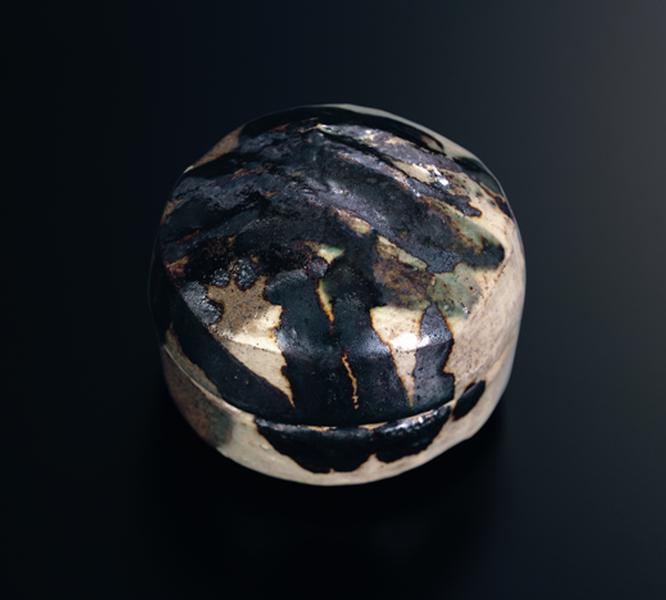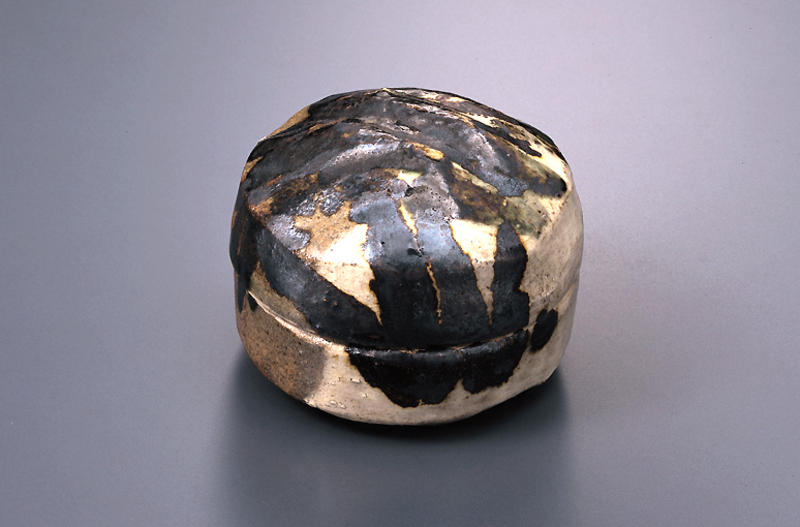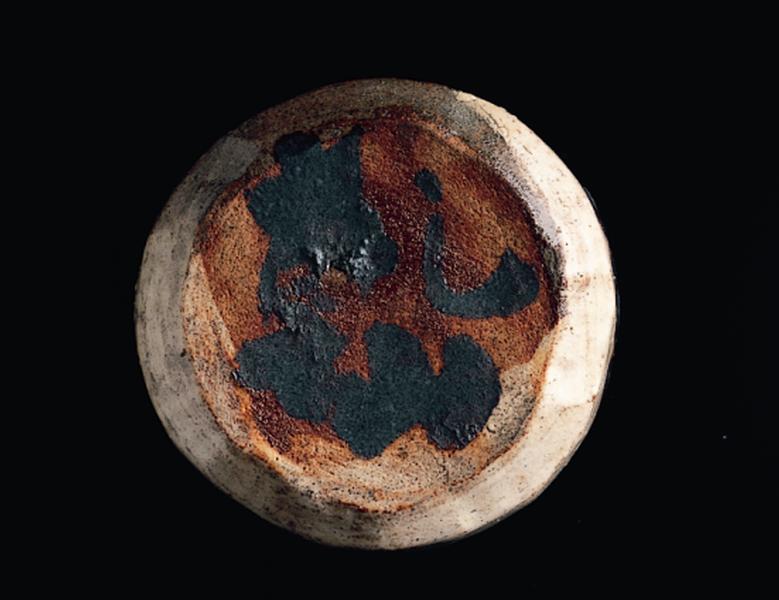乾山銹絵松文香合
- 京都
- 江戸時代
- 18-19c
- 乾山陶製、鉄絵
- H-4.6 D-6
整った円形を呈していないが、轆轤挽きで成形している。蓋から身にかけての半身に白泥が刷毛塗りされ、蓋の外面一杯に銹絵で松の樹が4本下絵付されている。下絵の上には透明釉がかけられているが、底部は露胎で、内面も白泥の塗布だけにとどまっている。底裏に銹絵銘で「乾山」と記されているが、書体からは製作時期を特定することは難しい。
江戸時代 18-19世紀
高:4.6cm 径:6.3cm
丸鑿状の工具を用いて,蓋の上面には一条,内面には五条の削りが加えられている。整った円形を呈していないが,側面から腰部にかけて鉋目が観察できるので,轆轤を用いて作られていることがわかる。
蓋から身にかけての半身に,白泥が刷毛塗りされ,蓋の外面いっぱいに銹絵で松の樹が四本下絵付けされている。松の樹は葉の部分にわずかに緑色の発色部分が認められ,一般的に乾山焼が比較的低い温度で焼成されていることを考え合わせるならば,銹絵の発色とは考えにくく,別種の絵の具で下絵付けされているのではないかと考えられる。下絵の上には透明釉が掛けられているが,底部は露胎であり,内面も白泥の塗布だけで,施釉はなされていない。
底裏に銹絵銘で「乾山」と記されているが,書体は乾山銘の時期的な変遷のなかには位置づけにくいもので,この作品の製作時期を特定することは極めて難しい。 (尾野)
尾形乾山
尾形乾山(おがたけんざん 1663~1743)
乾山は、寛文3年(1663)京都の富裕な呉服商尾形宗謙(おがたそうけん)の三男として生まれました。兄は画家の光琳です。二人の性格は対象的で、光琳が派手好みであったのに対し乾山は内省的、隠遁的な性格の持主であったといわれています。
野々村仁清に陶芸を学んだ乾山は、元禄12年(1699)37歳のとき京都市の鳴滝に開窯しました。そして正徳2年(1712)50歳の乾山は、京市内の二条丁子屋町に移住し、多くの作品を手がけ「乾山焼」として世にもてはやされました。鳴滝時代の末期からこの丁子屋町時代にかけて兄の光琳は絵付で乾山を助け、兄弟合作の作品が数多く残されています。
享保16年(1731)69歳の頃に江戸に下り寛永寺(かんえいじ)領入谷(いりや)に窯を築いて晩年を送りました。そして81歳で没するまで江戸に在住し陶器や絵画の制作に手腕を発揮しました。
乾山の作品は陶芸作品のみならず書や絵画においても、俗気を脱したおおらかで文人的な洒脱味があります。陶芸作品においては成形、施釉、焼成は他の専門的な陶工に任せたり、絵付についても光琳との合作以外に複数の専門画家が携わっていたと思われるなど、基本的には工房生産という態勢をとっていたようです。しかし、乾山の指導のもとにつくられたやきものには、その大胆なデザイン感覚とともに乾山特有の芸術性が溢れ、乾山その人とふれあうような親しみが感じられるのです。
乾山銹絵染付掻落絵替汁次
乾山銹絵染付梅波文蓋物
乾山立鶴図黒茶碗
乾山銹絵染付桔梗図筒向付
乾山銹絵染付草文四方鉢
乾山銹絵染付松図茶碗
乾山色絵短冊皿
乾山銹絵絵替長平皿
乾山色絵寿字輪花向付
乾山銹絵絵替四方皿
乾山銹絵染付絵替筒向付
乾山銹絵染付松図茶碗
乾山色絵椿文向付
乾山銹絵染付春草図茶碗
乾山銹絵染付藤図向付
乾山色絵立葵図向付
乾山色絵雪杉図向付
乾山色絵桔梗文盃台
乾山銹絵馬図香合
乾山銹絵染付絵替扇形向付
乾山銹絵掻落雲唐草文大鉢
乾山銹絵草花波文水指
乾山銹絵染付絵替土器皿
乾山色絵槍梅図茶碗
乾山黒楽梅図茶碗
乾山銹絵染付芙蓉図茶碗
銹絵掻落牡丹唐草文香合
撫子図(尾形乾山筆)
乾山色絵和歌陶板
乾山色絵竜田川図向付
乾山銹絵牡丹画角皿 尾形光琳画
乾山銹絵百合形向付
乾山色絵阿蘭陀写市松文猪口
乾山色絵薄図蓋茶碗
乾山銹絵菊図水指
鶴亀図黒茶碗
紅葉図 尾形乾山筆
三十六歌仙絵/在原業平像 尾形乾山筆
三十六歌仙絵/斎宮女御像 尾形乾山筆
乾山色絵菊文手付汁次
三十六歌仙絵/小野小町像 尾形乾山筆
乾山銹絵染付山水図茶碗
Catalogue Entry
Edo period, 18th to 19th centuries
Kenzan ware, underglaze iron brown
Height, 4.6cm; diameter, 6.3cm
Using a rounded chisel tool, the top of the lid was carved with one band of incised line, while the interior of the lid was banded with 5 incised lines. While this does not have a formed, rounded shape, planing marks can be discerned from the side to the hips and indicate that the work was wheel-thrown.
Half of the container, extending from lid to body, has been brushed in a white slip, and the exterior of the lid has been decorated with 4 pine trees brushed in underglaze iron. A small amount of green color effect can be discerned on the needle portions of the pine trees. If this is considered in accordance with the fact that Kenzan ware was generally fired at a relatively low temperature, it would be hard to imagine that this green developed from the iron under-glaze; thus it should be considered to be an example of underglaze painting in a different type of pigment. A transparent glaze has been applied on top of the underglaze, but the bottom has been left unglazed, and the interior has only been coated with a white slip, without a covering glaze.
The bottom of the foot is inscribed "Kenzan" in iron underglaze, but as the calligraphy style is hard to place within the period transitions seen in Kenzan signatures, it is extremely difficult to determine a date of production for this work. YO


